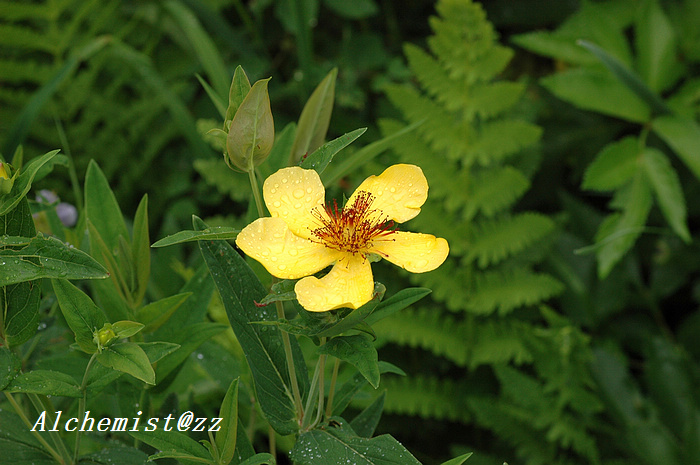- Scientific Name: Hypericum ascyron L.
- Ref: Sp. Pl.:783. 1753
- Synonyms: Ascyrum sibiricum Poir., Ascyrum tetragonum Moench, Roscyna gmelinii Spach
- English Common Name: giant St. John’s wort
- Chinese Common Name: 黄海棠 huáng∙hǎitáng, 长柱金丝桃 chángzhù jīnsī∙táo
- Japanese Common Name: トモエソウ [巴草] tomoesō
- Family: Hypericaceae
- Genus: Hypericum
- Distribution: Moist to dry meadows, grassy or rocky slopes, sometimes in forests or among scrub, streamsides and river banks; sea level to 2800(-3600) m. Throughout China except Xizang [Japan, Korea, Mongolia, Russia (Altay to Kamchatka and Kurile Islands, Sakhalin), Vietnam; North America (E Canada, NE United States)].
- Photo: 07/14/2008, Mt. Changbai, Jilin
Herbs, perennial, 0.5-1.3(-2) m tall, erect or sometimes ascending from short creeping base; stems single or few, cespitose, unbranched or branched above or nearly throughout. Stems 4-angled when young, becoming 4-lined or occasionally internodes 2-lined below. Leaves sessile; blade lanceolate or ± narrowly ovate or oblong or elliptic to oblong-linear or oblanceolate, (3-)4-9.7(-12) × (0.4-)0.7-3.5(-4) cm, thickly papery, abaxially rather paler but not glaucous; laminar glands dense, unequal dots or short streaks; intramarginal glands dense; main lateral veins 4-7-paired, tertiary reticulation dense, often obscure; base cuneate to cordate-amplexicaul, apex acute to subapiculate or obtuse (or lowermost rarely rounded). Inflorescence 1- to ca. 35-flowered from 1-5 nodes, the whole nearly flat-topped to narrowly pyramidal, sometimes with flowering branches from up to 4 nodes below; bracts and bracteoles leaflike but smaller and often broader, more rarely linear-lanceolate and deciduous. Flowers 3-7(-8) cm in diam., stellate with petals spreading to reflexed; buds broadly to narrowly ovoid, apex rounded to subacute. Sepals free, erect, oblong to elliptic or ovate to ovate-lanceolate or obovate, subequal to unequal, the outer ones sometimes leaflike, (0.3-)0.5-1.5 cm × (1.5-)2-7(-10) mm; laminar glands lines, distally interrupted to streaks; marginal glands spaced, small, margin entire, apex rounded to obtuse or rarely subacuminate to acute; veins 11-17. Petals bright (to ?golden) yellow, sometimes tinged red in bud, obovate or oblong-obovate to oblanceolate, often somewhat spatulate to subunguiculate, strongly curved to nearly straight, 1.4-4.1 × 0.5-2 cm, 2-3 × as long as sepals or shorter when sepals leaflike; laminar glands lines to short streaks; marginal glands absent; margin entire, apex rounded or obtuse to rarely acute to acuminate; apiculus short and rounded or absent. Stamen fascicles (?4 or)5, each with ca. 30 stamens, longest 0.9-2.5 cm, 0.4-0.67 × as long as petals. Ovary broadly ovoid to narrowly ovoid-pyramidal or ellipsoid; styles (4 or)5, 2.5-15 mm, 0.5-2 × as long as ovary, free or up to 0.8 coherent or connate; stigmas broadly capitate to funnel-shaped. Capsule broadly to narrowly ovoid or ovoid-pyramidal or rarely narrowly cylindric, 0.9-2.2(-3) cm × 5-13 mm, 2-3 × as long as sepals, apex obtuse to rounded. Seeds dark red-brown to yellow-brown, 1-1.5 mm, deeply carinate or narrowly winged, sometimes with slight terminal expansion; testa densely shallowly linear-reticulate. Fl. Jun-Sep, fr. Aug-Oct. 2n = 16, 18, 20, 22 (usually 18). (Flora of China)
